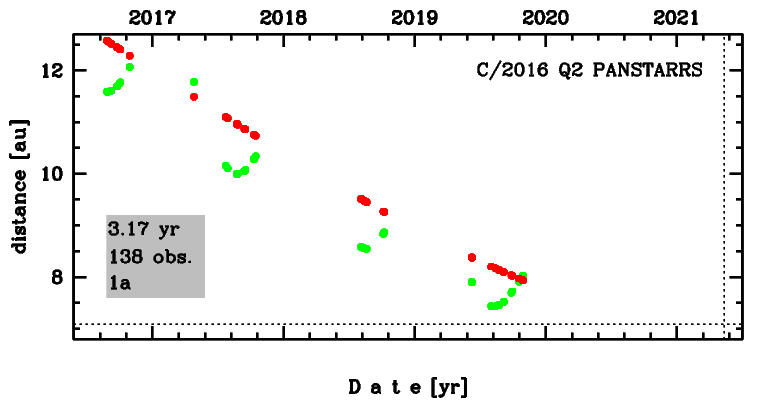C/2016 Q2 PANSTARRS
more info
Comet C/2016 Q2 was discovered on 26 August 2016 with Pan-STARRS 1 telescope (Haleakala), that is more then 5 years before its perihelion passage. In 2020, this comet is still on its orbital journey towards perihelion.
Comet will have its closest approach to the Earth on 24 May 2021 (6.805 au), about 2 weeks after its perihelion passage.
Solution given here is based on data spanning over 3.17 yr in a range of heliocentric distances from 12.58 au to 7.94 au (29 October 2019).
This is comet with original semimajor axis of about 7,800 au.
Comet will have its closest approach to the Earth on 24 May 2021 (6.805 au), about 2 weeks after its perihelion passage.
Solution given here is based on data spanning over 3.17 yr in a range of heliocentric distances from 12.58 au to 7.94 au (29 October 2019).
This is comet with original semimajor axis of about 7,800 au.
| solution description | ||
|---|---|---|
| number of observations | 138 | |
| data interval | 2016 08 26 – 2019 10 29 | |
| data type | observed only before perihelion (PRE) | |
| data arc selection | entire data set (STD) | |
| range of heliocentric distances | 12.58 au – 7.94au | |
| detectability of NG effects in the comet's motion | NG effects not determinable | |
| type of model of motion | GR - gravitational orbit | |
| data weighting | YES | |
| number of residuals | 270 | |
| RMS [arcseconds] | 0.32 | |
| orbit quality class | 1a | |
| orbital elements (heliocentric ecliptic J2000) | ||
|---|---|---|
| Epoch | 2021 09 23 | |
| perihelion date | 2021 05 11.99367501 | ± 0.00407506 |
| perihelion distance [au] | 7.08192824 | ± 0.00003107 |
| eccentricity | 1.00118204 | ± 0.00001032 |
| argument of perihelion [°] | 84.535793 | ± 0.000375 |
| ascending node [°] | 322.295182 | ± 0.000011 |
| inclination [°] | 109.388256 | ± 0.000029 |
| reciprocal semi-major axis [10-6 au-1] | -166.91 | ± 1.45 |
